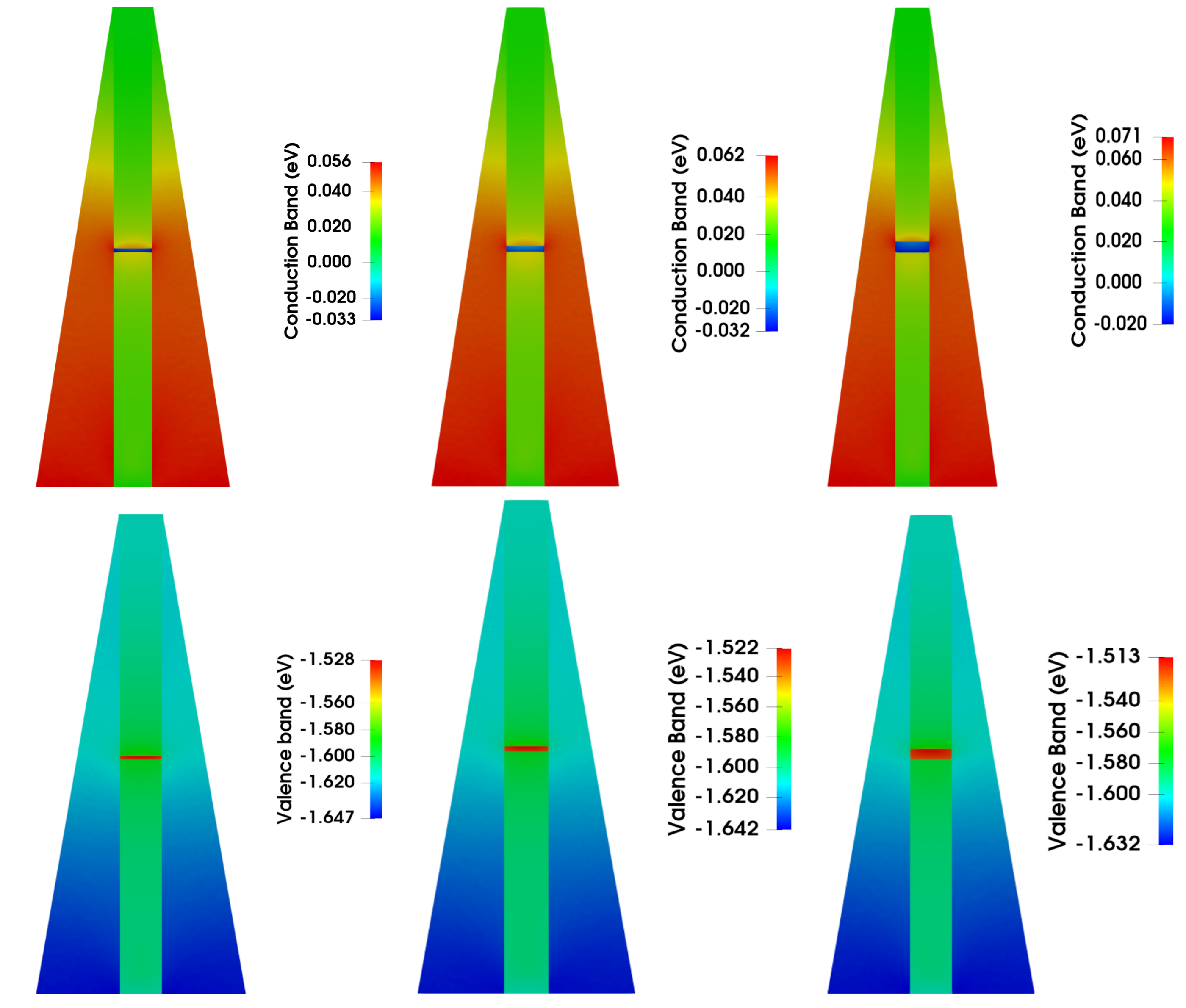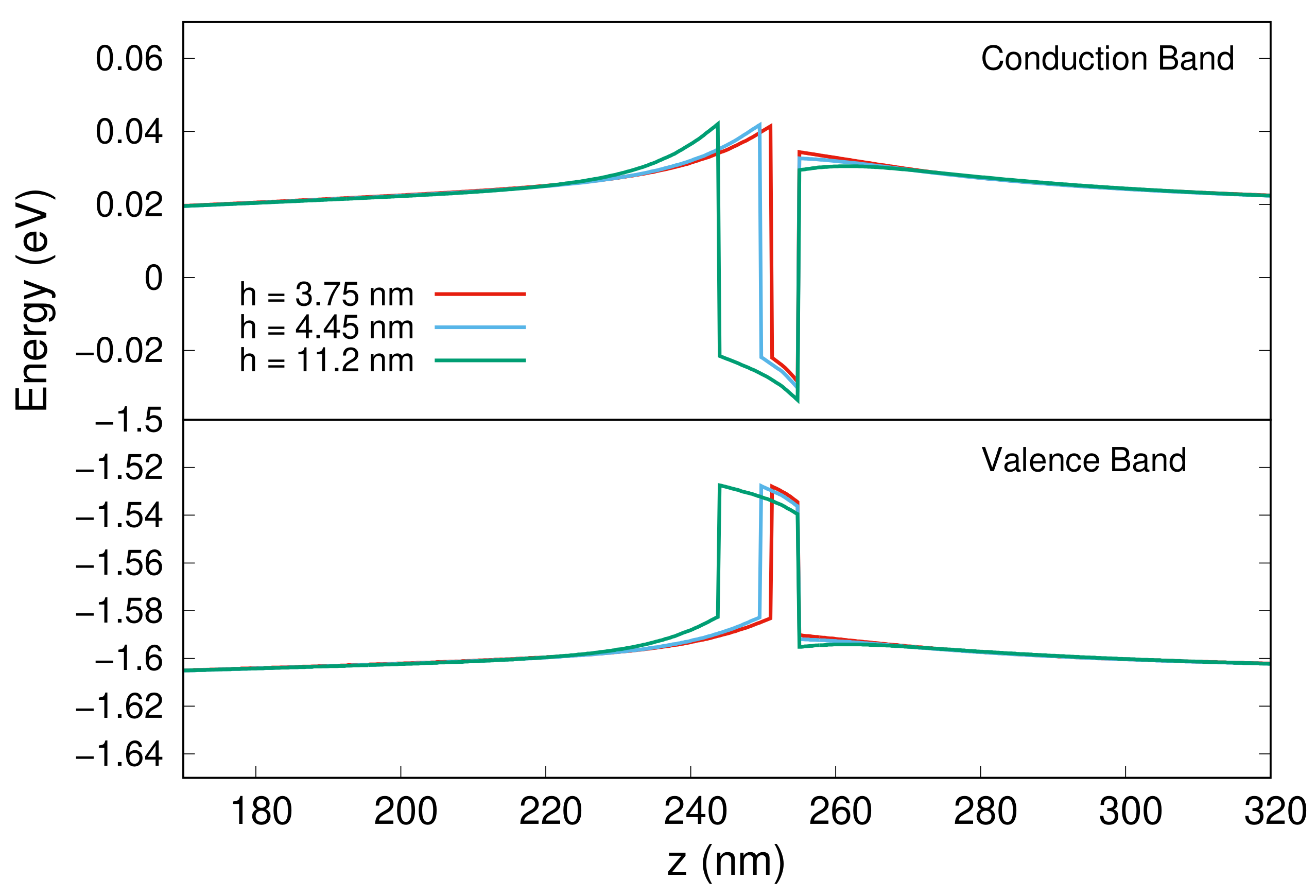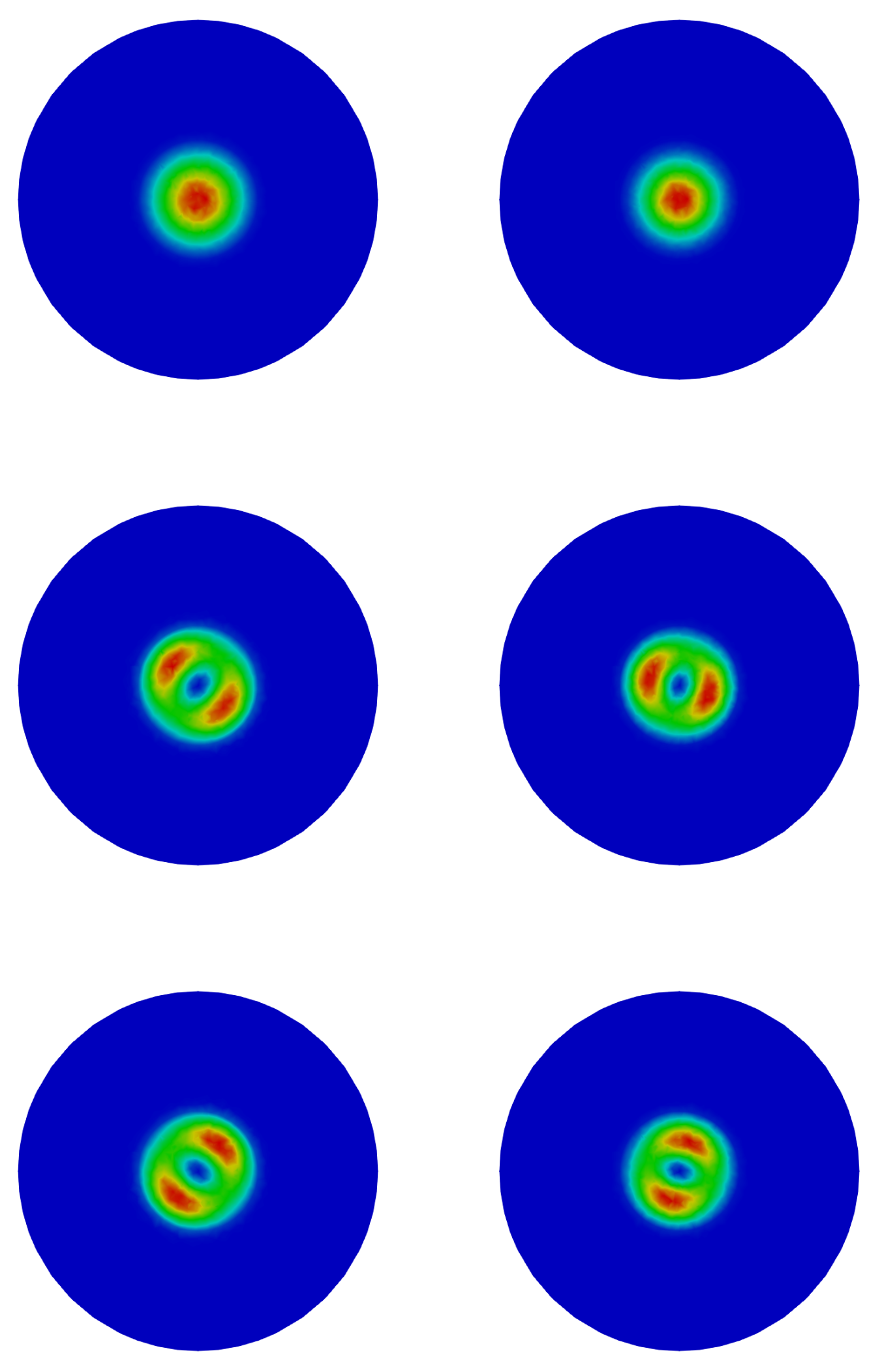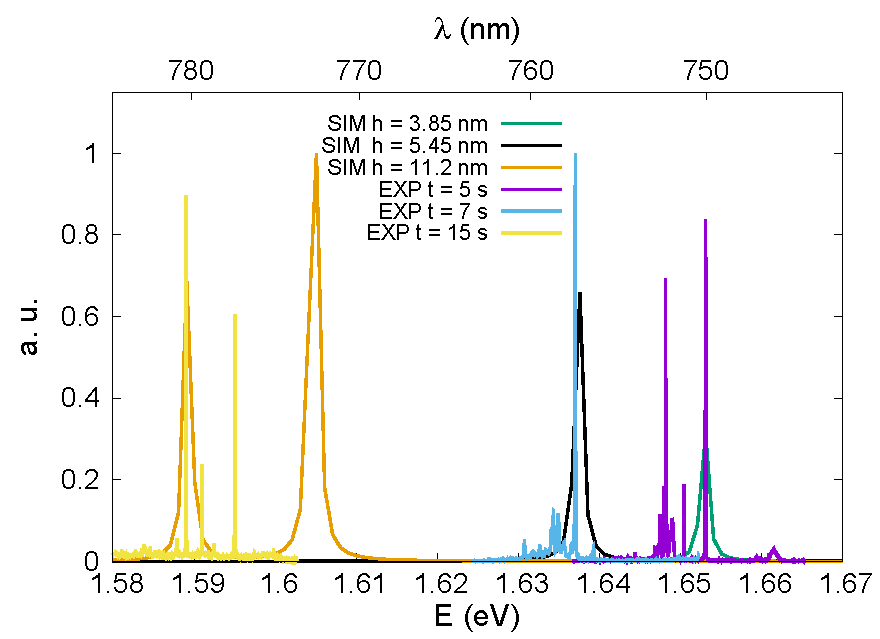Model of a GaAs Quantum Dot in a Direct Band Gap AlGaAs Wurtzite Nanowire
Abstract
1. Introduction
2. Structure and Models
3. Results
4. Conclusions
Author Contributions
Funding
Data Availability Statement
Acknowledgments
Conflicts of Interest
Abbreviations
| Wz | Wurtzite |
| MBE | Molecular Beam Epitaxy |
| TB | Tight-binding |
| QDs | Quantum dots |
| Zb | Zincblende |
| GS | Ground state |
References
- Caroff, P.; Bolinsson, J.; Johansson, J. Crystal phases in III–V nanowires: From random toward engineered polytypism. IEEE J. Sel. Top. Quantum. Electron. 2011, 17, 829–846. [Google Scholar] [CrossRef]
- Cui, Y.; Lieber, C.M. Functional Nanoscale Electronic Devices Assembled Using Silicon Nanowire Building Blocks. Science 2001, 291, 851–853. [Google Scholar] [CrossRef] [PubMed]
- Qian, F.; Li, Y.; Gradečak, S.; Park, H.-G.; Yaji, D.; Dong, Y.; Ding, Y.; Wang, Z.L.; Lieber, C.M. Multi-quantum-well nanowire heterostructures for wavelength-controlled lasers. Nat. Mater. 2008, 7, 701–706. [Google Scholar] [CrossRef] [PubMed]
- Nadj-Perge, S.; Frolov, S.M.; Bakkers, E.P.A.M.; Kouwenhoven, L.P. Spin-orbit qubit in a semiconductor nanowire. Nature 2010, 468, 1084–1087. [Google Scholar] [CrossRef] [PubMed]
- Hastrup, J.; Leandro, L.; Akopian, N. All-optical charging and charge transport in quantum dots. Sci. Rep. 2020, 10, 14911. [Google Scholar] [CrossRef]
- Li, D.; Akopian, N. Location qubits in a multi-quantum-dot system. arXiv 2021, arXiv:2107.05960. [Google Scholar] [CrossRef]
- Hackl, L.; Li, D.; Akopian, N.; Christandl, M. Experimental proposal to probe the extended Pauli principle. arXiv 2021, arXiv:2107.05961. [Google Scholar]
- Hoang, T.B.; Moses, A.F.; Zhou, H.L.; Dheeraj, D.L.; Fimland, B.O.; Weman, H. Observation of free exciton photoluminescence emission from single wurtzite GaAs nanowires. Appl. Phys. Lett. 2009, 94, 133105. [Google Scholar] [CrossRef]
- Ketterer, B.; Heiss, M.; Uccelli, E.; Arbiol, J.; Fontcuberta i Morral, A. Untangling the Electronic Band Structure of Wurtzite GaAs Nanowires by Resonant Raman Spectroscopy. ACS Nano 2011, 5, 7585–7592. [Google Scholar] [CrossRef]
- Leandro, L.; Hastrup, J.; Reznik, R.; Cirlin, G.; Akopian, N. Resonant excitation of nanowire quantum dots. NPJ Quantum. Inf. 2020, 6, 93. [Google Scholar] [CrossRef]
- Leandro, L.; Gunnarsson, C.P.; Reznik, R.; Jöns, K.D.; Shtrom, I.; Khrebtov, A.; Kasama, T.; Zwiller, V.; Cirlin, G.; Akopian, N. Nanowire Quantum Dots Tuned to Atomic Resonances. Nano Lett. 2018, 18, 7217–7221. [Google Scholar] [CrossRef] [PubMed]
- Jacobsson, D.; Panciera, F.; Tersoff, J.; Reuter, M.C.; Lehmann, S.; Hofmann, S.; Dick, K.A.; Ross, F.M. Interface dynamics and crystal phase switching in GaAs nanowires. Nature 2016, 531, 317–322. [Google Scholar] [CrossRef] [PubMed]
- Harmand, J.-C.; Patriarche, G.; Glas, F.; Panciera, F.; Florea, I.; Maurice, J.-L.; Travers, L.; Ollivier, Y. Atomic Step Flow on a Nanofacet. Phys. Rev. Lett. 2018, 121, 166101. [Google Scholar] [CrossRef] [PubMed]
- Gudiksen, M.S.; Lauhon, L.J.; Wang, J.; Smith, D.C.; Lieber, C.M. Growth of nanowire superlattice structures for nanoscale photonics and electronics. Nature 2002, 415, 617–620. [Google Scholar] [CrossRef]
- Algra, R.E.; Verheijen, M.A.; Borgström, M.T.; Feiner, L.-F.; Immink, G.; van Enckevort, W.J.P.; Vlieg, E.; Bakkers, E.P.A.M. Twinning superlattices in indium phosphide nanowires. Nature 2008, 456, 369–372. [Google Scholar] [CrossRef]
- Akopian, N.; Patriarche, G.; Liu, L.; Harmand, J.-C.; Zwiller, V. Crystal phase quantum dots. Nano Lett. 2010, 10, 1198–1201. [Google Scholar] [CrossRef]
- Vainorius, N.; Lehmann, S.; Jacobsson, D.; Samuelson, L.; Dick, K.A. Confinement in Thickness-Controlled GaAs Polytype Nanodots. Nano Lett. 2015, 15, 2652–2656. [Google Scholar] [CrossRef]
- Bavinck, M.B.; Jöns, K.D.; Zieliński, M.; Patriarche, G.; Harmand, J.-C.; Akopian, N.; Zwiller, V. Photon Cascade from a Single Crystal Phase Nanowire Quantum Dot. Nano Lett. 2016, 16, 1081–1085. [Google Scholar] [CrossRef]
- Dubrovskii, V.G.; Shtrom, I.V.; Reznik, R.R.; Samsonenko, Y.B.; Khrebtov, A.I.; Soshnikov, I.P.; Rouvimov, S.; Akopian, N.; Kasama, T.; Cirlin, G.E. Origin of spontaneous core-shell AlGaAs nanowires grown by molecular beam epitaxy. Cryst. Growth Des. 2016, 16, 7251–7255. [Google Scholar] [CrossRef]
- Priante, G.; Glas, F.; Patriarche, G.; Pantzas, K.; Oehler, F.; Harmand, J.-C. Sharpening the Interfaces of Axial Heterostructures in Self-Catalyzed AlGaAs Nanowires: Experiment and Theory. Nano Lett. 2016, 16, 1917–1924. [Google Scholar] [CrossRef]
- Heinrich, J.; Huggenberger, A.; Heindel, T.; Reitzenstein, S.; Höfling, S.; Worschech, L.; Forchel, A. Single Photon Emission from Positioned GaAs/AlGaAs Photonic Nanowires. Appl. Phys. Lett. 2010, 96, 211117. [Google Scholar] [CrossRef]
- Kats, V.N.; Kochereshko, V.P.; Platonov, A.V.; Chizhova, T.V.; Cirlin, G.E.; Bouravleuv, A.D.; Samsonenko, Y.B.; Soshnikov, I.P.; Ubyivovk, E.V.; Bleuse, J.; et al. Optical Study of GaAs Quantum Dots Embedded into AlGaAs Nanowires. Semicond. Sci. Technol. 2012, 27, 015009. [Google Scholar] [CrossRef]
- Barettin, D.; Platonov, A.V.; Pecchia, A.; Kats, V.N.; Cirlin, G.E.; Soshnikov, I.P.; Bouravleuv, A.D.; Besombes, L.; Mariette, H.; Auf der Maur, M.; et al. Model of a GaAs Quantum Dot Embedded in a Polymorph AlGaAs Nanowire. IEEE J. Sel. Top. Quantum. Electron. 2013, 19, 5. [Google Scholar] [CrossRef]
- Barettin, D.; Shtrom, I.V.; Reznik, R.R.; Mikushev, S.V.; Cirlin, G.E.; Auf der Maur, M.; Akopian, N. Direct Band Gap AlGaAs Wurtzite Nanowires. Nano Lett. 2023, 23, 895–901. [Google Scholar] [CrossRef] [PubMed]
- Zanolli, Z.; Fuchs, F.; Furthümller, J.; von Barth, U.; Bechstedt, F. Model GW band structure of InAs and GaAs in the wurtzite phase. Phys. Rev. B 2007, 75, 245121. [Google Scholar] [CrossRef]
- De, A.; Pryor, C.E. Predicted band structures of III–V semiconductors in the wurtzite phase. Phys. Rev. B 2010, 81, 155210. [Google Scholar] [CrossRef]
- Jancu, J.-M.; Gauthron, K.; Largeau, L.; Patriarche, G.; Harmand, J.-C.; Voisin, P. Type II heterostructures formed by zinc-blende inclusions in InP and GaAs wurtzite nanowires. Appl. Phys. Lett. 2010, 97, 041910. [Google Scholar] [CrossRef]
- Patera, M.; Zieliński, Z. Crystal field splitting and spontaneous polarization in InP crystal phase quantum dots. Sci. Rep. 2022, 12, 15561. [Google Scholar] [CrossRef]
- Patera, M.; Zieliński, M. Antibonding ground states in crystal phase quantum dots. Phys. Rev. B 2022, 106, L041405. [Google Scholar] [CrossRef]
- Lew Yan Voon, L.C.; Willatzen, M. The k·p Method: Electronic Properties of Semiconductors; Springer: Berlin/Heidelberg, Germany, 2009. [Google Scholar]
- Marquardt, O.; Caro, M.A.; Koprucki, T.; Mathé, P.; Willatzen, M. Multiband k·p model and fitting scheme for ab initio based electronic structure parameters for wurtzite GaAs. Phys. Rev. B 2020, 101, 235147. [Google Scholar] [CrossRef]
- Leandro, L.; Reznik, R.; Clement, J.D.; Repän, J.; Ubyivovk, E.V.; Shtrom, I.V.; Cirlin, G.; Akopian, N. Wurtzite AlGaAs Nanowires. Sci. Rep. 2020, 10, 735. [Google Scholar] [CrossRef] [PubMed]
- Signorello, G.; Lörtscher, E.; Khomyakov, P.; Karg, S.; Dheeraj, D.L.; Gotsmann, B.; Weman, H.; Riel, H. Inducing a direct-to-pseudodirect bandgap transition in wurtzite GaAs nanowires with uniaxial stress. Nat. Commun. 2014, 5, 3655. [Google Scholar] [CrossRef] [PubMed]
- Bechstedt, F.; Belabbes, A. Structure, energetics, and electronic states of III–V compound polytypes. J. Phys. Condens. Matter 2013, 25, 273201. [Google Scholar] [CrossRef] [PubMed]
- Marquardt, O.; Ramsteiner, M.; Corfdir, P.; Geelhaar, L.; Brandt, O. Modeling the electronic properties of GaAs polytype nanostructures: Impact of strain on the conduction band character. Phys. Rev. B 2017, 95, 245309. [Google Scholar] [CrossRef]
- Mohseni, P.K.; Behnam, A.; Wood, J.D.; English, C.D.; Lyding, J.W.; Pop, E.; Li, X. InxGa1-xAs Nanowire Growth on Graphene: Van der Waals Epitaxy Induced Phase Segregation. Nano Lett. 2013, 13, 1153. [Google Scholar] [CrossRef]
- Guo, Y.-N.; Xu, H.-Y.; Auchterlonie, G.J.; Burgess, T.; Joyce, H.J.; Gao, Q.; Tan, H.H.; Jagadish, C.; Shu, H.-B.; Chen, X.-S.; et al. Phase separation induced by Au catalysts in ternary InGaAs nanowires. Nano Lett. 2013, 13, 643. [Google Scholar] [CrossRef]
- Zhang, Y.; Sanchez, A.M.; Wu, J.; Aagesen, M.; Holm, J.V.; Beanland, R.; Ward, T.; Liu, H. Polarity-Driven Quasi-3-Fold Composition Symmetry of Self-Catalyzed III–V-V Ternary Core-Shell Nanowires. Nano Lett. 2015, 15, 3128. [Google Scholar] [CrossRef]
- Xu, T.; Dick, K.A.; Plissard, S.; Nguyen, T.H.; Makoudi, Y.; Berthe, M.; Nys, J.P.; Wallart, X.; Grandidier, B.; Caroff, P. Faceting, composition and crystal phase evolution in III–V antimonide nanowire heterostructures revealed by combining microscopy techniques. Nanotechnology 2012, 23, 095702. [Google Scholar] [CrossRef]
- Conesa-Boj, S.; Kriegner, D.; Han, X.-L.; Plissard, S.; Wallart, X.; Stangl, J.; Fontcuberta i Morral, A.; Caroff, P. Gold-free ternary III–V antimonide nanowire arrays on silicon: Twin-free down to the first bilayer. Nano Lett. 2014, 14, 326. [Google Scholar] [CrossRef]
- Lassen, B.; Barettin, D.; Willatzen, M. Strain in inhomogeneous InAs/GaAs quantum dot structures. J. Phys. Conf. Ser. 2012, 367, 012007. [Google Scholar] [CrossRef]
- Barettin, D.; De Angelis, R.; Prosposito, P.; Auf der Maur, M.; Casalboni, M.; Pecchia, A. Model of a realistic InP surface quantum dot extrapolated from atomic force microscopy results. Nanotechnology 2014, 25, 195201. [Google Scholar] [CrossRef] [PubMed]
- Auf Der Maur, M.; Barettin, D.; Pecchia, A.; Sacconi, F.; Di Carlo, A. Effect of alloy fluctuations in InGaN/GaN quantum wells on optical emission strength. In Proceedings of the International Conference on Numerical Simulation of Optoelectronic Devices, NUSOD, Palma de Mallorca, Spain, 1–4 September 2014; pp. 11–12. [Google Scholar] [CrossRef]
- Barettin, D.; Pecchia, A.; Auf der Maur, M.; Di Carlo, A.; Lassen, B.; Willatzen, M. Electromechanical field effects in InAs/GaAs quantum dots based on continuum k*p and atomistic tight-binding methods. Comput. Mater. Sci. 2021, 197, 110678. [Google Scholar] [CrossRef]
- Foreman, B.A. Effective-mass Hamiltonian and boundary conditions for the valence bands of semiconductor microstructures. Phys. Rev. B 1993, 48, 4964. [Google Scholar] [CrossRef] [PubMed]
- Burt, M.G. The evaluation of the matrix element for interband optical transitions in quantum wells using envelope functions. J. Phys. Condens. Matter 1993, 5, 4091. [Google Scholar] [CrossRef]
- Pokatilov, E.P.; Fonoberov, V.A.; Fomin, V.M.; Devreese, J.T. Development of an eight-band theory for quantum dot heterostruc- tures. Phys. Rev. B 2001, 64, 245328. [Google Scholar] [CrossRef]
- Barettin, D.; Madsen, S.; Lassen, B.; Willatzen, M. Computational Methods for Electromechanical Fields in Self-Assembled Quantum Dots. Commun. Comput. Phys. 2012, 11, 797–830. [Google Scholar] [CrossRef]
- Barettin, D.; Lassen, B.; Willatzen, M. Electromechanical fields in GaN/AlN Wurtzite Quantum Dots. J. Phys. Conf. Ser. 2008, 107, 012001. [Google Scholar] [CrossRef]
- Bir, G.L.; Pikus, G.E. Symmetry and Strain-Induced Effects in Semiconductors; Wiley: New York, NY, USA, 1974; p. 295. [Google Scholar]
- Martin, R.M. Relation between Elastic Tensors of Wurtzite and Zinc-Blende Structure Materials. Phys. Rev. B 1972, 6, 4546. [Google Scholar] [CrossRef]
- Wright, A.F. Elastic properties of zinc-blende and wurtzite AlN, GaN, and InN. J. Appl. Phys. 1997, 82, 6. [Google Scholar] [CrossRef]
- Bernardini, F.; Fiorentini, V.; Vanderbilt, D. Spontaneous polarization and piezoelectric constants of III–V nitrides. Phys. Rev. B 1997, 56, R10024. [Google Scholar] [CrossRef]
- Al-Zahrani, H.Y.S.; Pal, J.; Migliorato, M.A.; Tse, G.; Yu, D. Piezoelectric field enhancement in III–V core-shell nanowires. Nano Energy 2015, 14, 382. [Google Scholar] [CrossRef]
- Xin, J.; Zheng, Y.; Shi, E. Piezoelectricity of zinc-blende and wurtzite structure binary compounds. Appl. Phys. Lett. 2007, 91, 112902. [Google Scholar] [CrossRef]
- Alekseev, P.A.; Sharov, V.A.; Geydt, P.; Dunaevskiy, M.S.; Lysak, V.V.; Cirlin, G.E.; Reznik, R.R.; Khrebtov, A.I.; Soshnikov, I.P.; Lähderanta, E. Piezoelectric current generation in wurtzite GaAs nanowires. Phys. Status. Solidi 2017, 12, 1700358. [Google Scholar] [CrossRef]
- Lysak, V.V.; Soshnikov, I.P.; Lähderanta, E.; Cirlin, G.E. Piezoelectric effect in wurtzite GaAs nanowires: Growth, characterization, and electromechanical 3D modeling. Phys. Status Solidi A 2016, 213, 3014. [Google Scholar] [CrossRef]
- Zhao, L.-X.; Liu, J. Piezoelectricity in binary wurtzite semiconductors: A first-principles study. Appl. Phys. Express 2021, 14, 121003. [Google Scholar] [CrossRef]
- Schliwa, A.; Winkelnkemper, M.; Bimberg, D. Impact of size, shape, and composition on piezoelectric effects and electronic properties of In(Ga)As/GaAs quantum dots. Phys. Rev. B 2007, 76, 205324. [Google Scholar] [CrossRef]
- Barettin, D.; Houmark, J.; Lassen, B.; Mørk, J.; Jauho, A.-P. Optical properties and optimization of electromagnetically induced transparency in strained InAs/GaAs quantum dot structures. Phys. Rev. B 2009, 80, 235304. [Google Scholar] [CrossRef]
- Stier, O.; Grundmann, M.; Bimberg, D. Electronic and optical properties of strained quantum dots modeled by 8-band k·p theory. Phys. Rev. B 1999, 59, 5688. [Google Scholar] [CrossRef]
- Masharin, M.A.; Berestennikov, A.S.; Barettin, D.; Voroshilov, P.M.; Ladutenko, K.S.; Di Carlo, A.; Makarov, S.V. Giant enhancement of radiative recombination in perovskite light-emitting diodes with plasmonic core-shell nanoparticles. Nanomaterials 2021, 11, 45. [Google Scholar] [CrossRef]
- Semenova, E.; Kulkova, I.; Kadkhodazadeh, S.; Barettin, D.; Kopylov, O.; Cagliani, A.; Almdal, K.; Willatzen, M.; Yvind, K. Epitaxial growth of quantum dots on InP for device applications operating at the 1.55 μm wavelength range. Proc. SPIE 2014, 8996, 9–17. [Google Scholar] [CrossRef]
- Waltereit, P.; Brandt, O.; Trampert, A.; Grahn, H.T.; Menniger, J.; Ramsteiner, M.; Reiche, M.; Ploog, K.H. Nitride semiconductors free of electrostatic fields for efficient white light-emitting diodes. Nature 2000, 406, 865. [Google Scholar] [CrossRef] [PubMed]
- Shapiro, N.A.; Feick, H.; Hong, W.; Cich, M.; Armitage, R.; Weber, E.R. Luminescence energy and carrier lifetime in InGaN/GaN quantum wells as a function of applied biaxial strain. J. Appl. Phys. 2003, 94, 4520. [Google Scholar] [CrossRef]
- Li, S.; Ware, M.; Wu, J.; Minor, P.; Wang, Z.; Wu, Z.; Jiang, Y.; Salamo, G. Polarization induced pn-junction without dopant in graded AlGaN coherently strained on GaN. J. Appl. Phys. Lett. 2012, 101, 122103. [Google Scholar] [CrossRef]
- Barettin, D.; Auf Der Maur, M.; di Carlo, A.; Pecchia, A.; Tsatsulnikov, A.F.; Sakharov, A.V.; Lundin, W.V.; Nikolaev, A.E.; Usov, S.O.; Cherkashin, N.; et al. Influence of electromechanical coupling on optical properties of InGaN quantum-dot based light-emitting diodes. Nanotechnology 2017, 28, 015701-10. [Google Scholar] [CrossRef]
- Shah, N.A.; Gul, M.; Abbas, M.; Amin, M. Synthesis of Metal Oxide Semiconductor Nanostructures for Gas Sensors. In Gas Sensors; IntechOpen: London, UK, 2019. [Google Scholar] [CrossRef]
- Pearton, S. GaN and Related Materials II, ser. Optoelectronic Properties of Semiconductors and Superlattices; Taylor & Francis: Oxfordshire, UK, 2000. [Google Scholar]






| Parameters | GaAs Wz | AlAs Wz |
|---|---|---|
| (nm) | 0.399 | 0.4002 |
| (nm) | 0.653 | 0.654 |
| (eV) | 0.010 | −0.169 |
| (eV) | 0.017 | 0.019 |
| (eV) | 0.202 | 0.300 |
| (eV) | 0.206 | 0.320 |
| −15.22 | −7.04 | |
| −2.86 | −2.12 | |
| 12.36 | 4.92 | |
| −7.18 | −3.46 | |
| −8.79 | −4.26 | |
| −12.43 | −6.02 | |
| (eV) | −6.8 | 1.0 |
| (eV) | −8.6 | −7.2 |
| (eV) | −3.7 | −17.1 |
| (eV) | 4.5 | 7.9 |
| (eV) | 8.2 | 8.8 |
| (eV) | −4.1 | −3.9 |
| (eV) | −4.0 | −3.4 |
| (eV) | −5.5 | −3.4 |
| (GPa) | 145 | 141 |
| (GPa) | 51 | 49 |
| (GPa) | 38 | 41 |
| (GPa) | 158 | 149 |
| (GPa) | 38 | 40 |
| (C/m) | 0.15 | −0.05 |
| (C/m) | −0.295 | 0.04 |
| (eV) | 1.506 | 2.232 |
| C (eV) | −0.076 | Bowing parameter |
| (AlAs-GaAs Wz) (eV) | −0.368 | Valence band offset |
Disclaimer/Publisher’s Note: The statements, opinions and data contained in all publications are solely those of the individual author(s) and contributor(s) and not of MDPI and/or the editor(s). MDPI and/or the editor(s) disclaim responsibility for any injury to people or property resulting from any ideas, methods, instructions or products referred to in the content. |
© 2023 by the authors. Licensee MDPI, Basel, Switzerland. This article is an open access article distributed under the terms and conditions of the Creative Commons Attribution (CC BY) license (https://creativecommons.org/licenses/by/4.0/).
Share and Cite
Barettin, D.; Shtrom, I.V.; Reznik, R.R.; Cirlin, G.E. Model of a GaAs Quantum Dot in a Direct Band Gap AlGaAs Wurtzite Nanowire. Nanomaterials 2023, 13, 1737. https://doi.org/10.3390/nano13111737
Barettin D, Shtrom IV, Reznik RR, Cirlin GE. Model of a GaAs Quantum Dot in a Direct Band Gap AlGaAs Wurtzite Nanowire. Nanomaterials. 2023; 13(11):1737. https://doi.org/10.3390/nano13111737
Chicago/Turabian StyleBarettin, Daniele, Igor V. Shtrom, Rodion R. Reznik, and George E. Cirlin. 2023. "Model of a GaAs Quantum Dot in a Direct Band Gap AlGaAs Wurtzite Nanowire" Nanomaterials 13, no. 11: 1737. https://doi.org/10.3390/nano13111737
APA StyleBarettin, D., Shtrom, I. V., Reznik, R. R., & Cirlin, G. E. (2023). Model of a GaAs Quantum Dot in a Direct Band Gap AlGaAs Wurtzite Nanowire. Nanomaterials, 13(11), 1737. https://doi.org/10.3390/nano13111737






